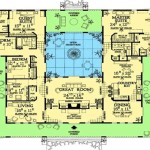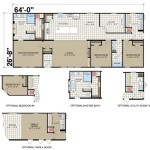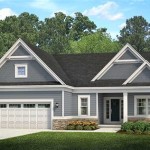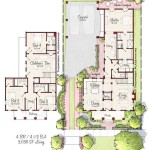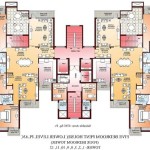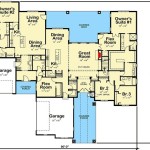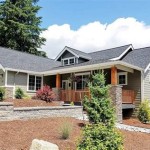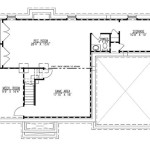Biggest Mansion Floor Plans: A Deep Dive into Luxury and Design
The concept of a "mansion" is often associated with opulence, space, and grandeur. However, the term itself is subjective, lacking a universally agreed-upon definition based solely on square footage. What one person considers a mansion might be merely a large house to another. Nevertheless, examining the floor plans of exceptionally large residences provides valuable insight into the design principles, functional considerations, and lifestyle aspirations that underpin these sprawling properties.
A mansion's floor plan goes beyond simply allocating rooms; it dictates the flow of movement, the relationship between different areas, and the overall experience of inhabiting the space. The sheer size of these dwellings necessitates careful planning to ensure functionality, privacy, and a cohesive aesthetic. Let us delve into the key aspects and common characteristics observed in the floor plans of some of the largest mansions worldwide. The focus will be on understanding the organizational elements and design considerations that make these structures both livable and impressive.
Zoning and Functional Separation
One of the most crucial elements in designing a large mansion floor plan is the strategic zoning of different areas. This ensures that spaces are used appropriately and that the occupants can enjoy privacy and functionality. Commonly, mansions are divided into several distinct zones:
Living/Entertaining Zone: This is typically the most public area of the house, designed for hosting guests and engaging in social activities. This zone often includes grand foyers, formal living rooms, dining rooms, ballrooms, libraries, and home theaters. The spatial planning here emphasizes openness and flow, creating a sense of grandeur and facilitating easy movement for large gatherings. The floor plan must carefully consider the sightlines and acoustics to ensure comfortable and enjoyable experiences for guests.
Private/Family Zone: This area is dedicated to the residents of the house and typically comprises bedrooms, bathrooms, family rooms, studies, personal gyms, and home offices. The design principle here prioritizes privacy and comfort. Master suites, in particular, are designed as self-contained retreats, often featuring private sitting areas, large walk-in closets, and luxurious bathrooms. The layout aims to create a sense of intimacy and relaxation, providing a sanctuary away from the more public areas of the house.
Service/Staff Zone: This zone is often less visible than the others, but it's crucial for the smooth functioning of the mansion. It includes kitchens, pantries, laundry rooms, staff quarters, garages, and utility rooms. The design focuses on practicality and efficiency, ensuring that the staff can perform their duties without interfering with the residents' privacy. This area usually has separate entrances and corridors to maintain discrete access. The placement of the kitchen is particularly important; it should be easily accessible from both the dining area and the service entrance.
Recreational Zone: Many mansions feature dedicated recreational spaces, such as indoor swimming pools, bowling alleys, game rooms, and spas. These zones are designed to provide entertainment and relaxation. The floor plan must accommodate the specific needs of these activities, considering factors like ventilation, lighting, and acoustics. The recreational zone is often located in a separate wing of the house or in the basement, ensuring that noise and activity don't disrupt the other areas.
Effective zoning ensures that the various functions of the mansion are accommodated without creating conflicts or compromising the overall flow of the house. The careful separation of these zones is critical for maintaining both privacy and functionality in a large residence.
The Importance of Scale and Proportion
In mansion floor plans, scale and proportion are paramount considerations. The sheer size of the rooms and hallways needs to be carefully balanced to avoid a sense of emptiness or disproportion. High ceilings are almost always a feature, adding to the sense of grandeur and spaciousness. But high ceilings also need to be proportional to the room's other dimensions to avoid making the space feel awkward or cavernous.
Hallways must be wide enough to accommodate the expected traffic flow, especially when entertaining. They should also be well-lit and aesthetically pleasing, often incorporating architectural details and artwork to avoid feeling like mere passageways. Staircases are another critical element, often designed as grand architectural features that contribute to the overall visual impact of the house. The width, height, and design of the staircase must be carefully considered to ensure both safety and aesthetic appeal.
The relationship between different rooms is also crucial. The floor plan should create a sense of visual connection and flow, allowing occupants to move easily from one space to another. This can be achieved through the strategic placement of doorways, archways, and windows, as well as the use of consistent design themes and materials. The overall design should create a harmonious and balanced environment, where the individual elements work together to create a cohesive whole.
Furthermore, the landscape design is an integral part of the overall scale and proportion. The mansion should be situated on the property in a way that maximizes its visual impact and creates a sense of harmony with the surrounding environment. The landscaping should complement the architecture of the house, creating a seamless transition between the interior and exterior spaces. Pools, gardens, and other outdoor features should be carefully integrated into the overall design, enhancing the visual appeal and functionality of the property.
The successful execution of scale and proportion in a mansion floor plan requires careful attention to detail and a deep understanding of architectural principles. It is this attention that transforms a large house into a truly impressive and livable mansion.
The Role of Technology and Automation
Modern mansions increasingly incorporate advanced technology and automation to enhance comfort, security, and efficiency. The floor plan must accommodate these technologies, providing space for wiring, equipment, and controls.
Smart home systems are now commonplace, allowing residents to control lighting, temperature, security, and entertainment systems from a central interface. The floor plan should include dedicated wiring closets and control rooms to house the necessary equipment. Furthermore, integrating these systems seamlessly into the décor, concealing wiring and controls, is essential for preserving the aesthetic appeal of the mansion.
Security systems are also a critical consideration. The floor plan should incorporate features such as surveillance cameras, alarm systems, and secure access points. Security rooms may be included to monitor and control the system. Strategic placement of sensors and cameras is important to ensure comprehensive coverage without compromising privacy.
Energy efficiency is another important aspect of modern mansion design. The floor plan can contribute to energy savings by optimizing natural light and ventilation, incorporating energy-efficient windows and insulation, and utilizing renewable energy sources. Solar panels, geothermal systems, and rainwater harvesting systems require dedicated space and infrastructure, which must be integrated into the floor plan. These technologies not only reduce the environmental impact of the mansion but also lower operating costs.
Dedicated home theaters, gaming rooms, and recording studios are also becoming increasingly common. These spaces require specialized acoustic treatment and equipment, which must be carefully considered during the design process. The floor plan should include soundproofed walls, specialized lighting, and dedicated equipment rooms to ensure optimal performance.
In conclusion, integrating technology and automation into a mansion floor plan requires careful planning and coordination. It is important to work with experienced architects and engineers to ensure that the technologies are seamlessly integrated into the architectural design, enhancing both the functionality and the aesthetic appeal of the mansion.

Mansion Floor Plan Plans Luxury House

1377 751 Mansion Floor Plan Luxury Plans Unique House

Humber House Mansion Plans Luxury

Pin On Floor Plans

Large House Plan Examples

Britain S Most Expensive Repossession Is 30million Mansion Floor Plan Architectural Plans House

Mansion Floor Plans Top No Layouts Design Ideas Architecture

1377 751 Mansion Floor Plan Luxury Plans Unique House

Imposing Mansion Floor Plans On With 23 Responses To James Mega Design Plan Designs

3800 Sq Ft Mediterranean House Floor Plan 4 Bed Bath

